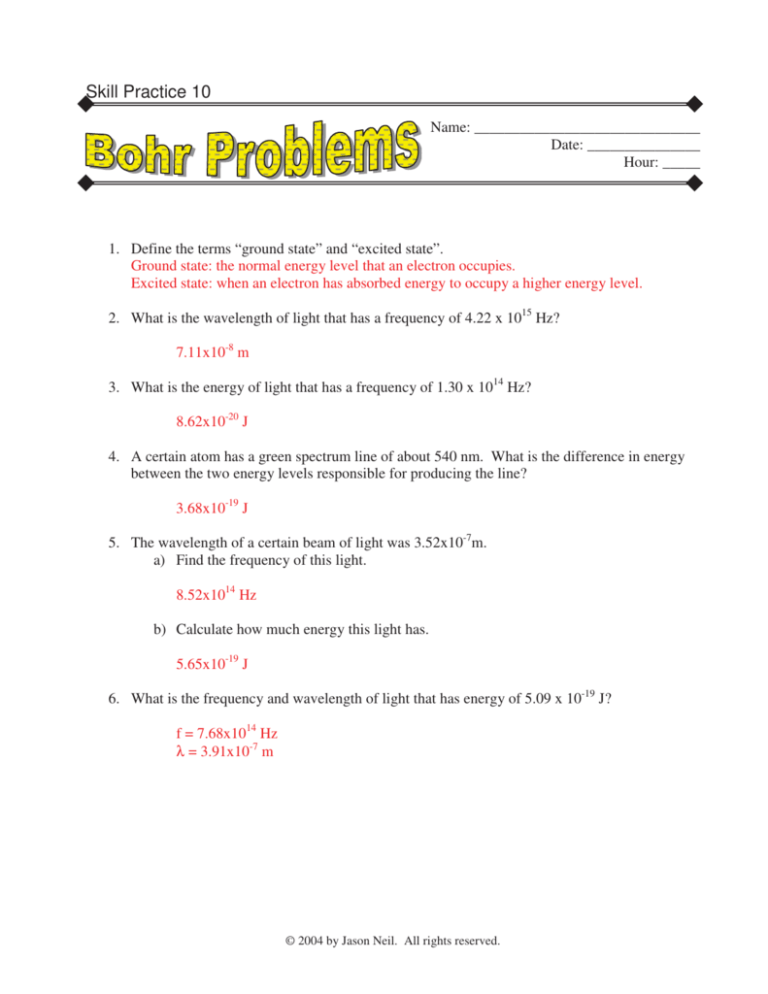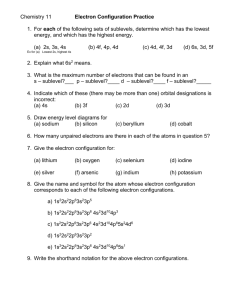
Skill Practice 10
Name: ______________________________
Date: _______________
Hour: _____
1. Define the terms “ground state” and “excited state”.
Ground state: the normal energy level that an electron occupies.
Excited state: when an electron has absorbed energy to occupy a higher energy level.
2. What is the wavelength of light that has a frequency of 4.22 x 1015 Hz?
7.11x10-8 m
3. What is the energy of light that has a frequency of 1.30 x 1014 Hz?
8.62x10-20 J
4. A certain atom has a green spectrum line of about 540 nm. What is the difference in energy
between the two energy levels responsible for producing the line?
3.68x10-19 J
5. The wavelength of a certain beam of light was 3.52x10-7m.
a) Find the frequency of this light.
8.52x1014 Hz
b) Calculate how much energy this light has.
5.65x10-19 J
6. What is the frequency and wavelength of light that has energy of 5.09 x 10-19 J?
f = 7.68x1014 Hz
λ = 3.91x10-7 m
© 2004 by Jason Neil. All rights reserved.
Skill Practice 11
Name: ______________________________
Date: _______________
Hour: _____
1. What is wrong with the following notation?
There is no such thing as an f sublevel in the third energy level. Also, an f sublevel if it
existed would have five orbitals instead of four.
2. How many sublevels would you expect in the 8th energy level?
8
3. What is the maximum number of electrons that can fit in the 3d sublevel?
10
4. How many electrons can fit in a 2p orbital?
2
5. In the 5th energy level, there is a fifth sublevel called the “g sublevel”. Considering the trend
in number of orbitals and electrons in the s, p, d, and f sublevels, predict how many orbitals
and how many electrons can fit in a g sublevel.
Orbitals = 9
Electrons = 18
6. Considering your answer to question 5, how many electrons can fit in the entire 5th energy
level?
50
7. Write the notation for an electron spinning clockwise in a p sublevel in the 4th energy level.
© 2004 by Jason Neil. All rights reserved.
Skill Practice 13
Name: ______________________________
Date: _______________
Hour: _____
1. Using arrows, write complete orbital diagrams for…
a) Scandium 1s
2s
2p
3s
3p
3s
3p
4s
3d
b) Molybdenum
1s
2s
2p
4s
3d
4p
5s
4d
c) Selenium
1s 2s 2p
3s 3p
4s 3d
2. Write the complete electron configuration (no arrows) for…
4p
a) Chromium
1s22s22p63s23p64s23d4
b) Antimony
1s22s22p63s23p64s23d104p65s24d105p3
c) Calcium
1s22s22p63s23p64s2
3. What is wrong with the following electron orbital diagram? What is the name of the rule that
allows you to identify the error?
The 2p sublevel should look like 2p
because of Hund’s Rule.
4. How many unpaired electrons does cobalt have?
Three
© 2004 by Jason Neil. All rights reserved.
Skill Practice 15
Name: ______________________________
Date: _______________
Hour: _____
1. Use the noble gases to write abbreviated electron configurations for…
a) Germanium
[Ar]4s23d104p2
b) Barium
[Xe]6s2
c) Bromine
[Ar]4s23d104p5
d) Bismuth
[Xe]6s24f145d106p3
e) Manganese
[Ar]4s23d5
f) Gold
[Xe]6s24f145d9
2. What column of the periodic table contains elements whose electron configurations end with
d4?
Column 6 (or VIB)
3. What row of the periodic table contains elements with 4d electrons?
5th row
4. What row of the periodic table contains elements with 3p electrons?
3rd row
5. In each row of the “d block” there are only 10 elements. Why is this?
Each d sublevel can hold 10 electrons.
6. In each row of the “p block” there are only 6 elements. Why is this?
Each p sublevel can hold 6 electrons.
© 2004 by Jason Neil. All rights reserved.
Skill Practice 16
Name: ______________________________
Date: _______________
Hour: _____
1. What force of attraction does the second energy level of a phosphorus atom “feel” from the
nucleus? Draw a Bohr diagram and use it to explain your answer.
The nucleus of a phosphorus atom has 15
protons (a +15 charge) which gets
weakened by 2 electrons in the first level
and 8 electrons in the 2nd level. Thus the
outer level feels a +5 charge from the
nucleus.
2. Using the concepts of shielding and attraction, explain why sulfur is smaller in radius than
silicon.
Sulfur’s outer level of electrons feels a +6 charge pulling on it from the nucleus.
Silicon’s outer level feels a weaker charge of +4 and therefore it is not pulled as close
to the nucleus as sulfur’s outer level.
3. Why can’t you tell by looking at the periodic table whether chlorine or lithium is larger?
Chlorine is lower in the periodic table which would indicate that it is larger than
lithium, but it is also located further to the right which would indicate that it is smaller.
4. Order the following elements from smallest to largest.
A) Al, Na, S, Mg
S, Al, Mg, Na
C) K, Se, Ca, Br
Br, Se, Ca, K
E) Ga, Al, Cl, P
Cl, P, Al, Ga
B) C, Sn, Pb, Si
C, Si, Sn, Pb
D) Be, Ca, C, B, Mg
C, B, Be, Mg, Ca
F) O, Se, S, Ne
Ne, O, S, Se
© 2004 by Jason Neil. All rights reserved.
Skill Practice 17
Name: ______________________________
Date: _______________
Hour: _____
1. If an atom has a “high first ionization energy” does this mean that it is relatively easy or
relatively hard to remove an electron from the atom?
It is relatively hard to remove the first electron.
2. Arrange the following atoms in order from lowest to highest 1st ionization energy.
A) Ca, Se, As, Br
Ca, As, Se, Br
C) Ga, Al, S, Si
Ga, Al, Si, S
E) Te, O, S, Po
Po, Te, S, O
B) As, N, P, Bi
Bi, As, P, N
D) Li, K, O, C
K, Li, C, O
F) In, Te, Sn, I
In, Sn, Te, I
3. A certain atom in the 2nd period has an unusually high 3rd ionization energy. Name this
element. Draw a Bohr diagram and use it to illustrate why you were able to identify this
atom.
Beryllium; below is the Bohr diagram for beryllium. Notice that after its two
outermost electrons are removed, the next electron would need to be removed from an
inner energy level, which is much more difficult.
4. Compare the trends for size and for ionization energy. As the size of an atom increases, what
happens to the ionization energy? Explain why the ionization energy seems to depend on the
size.
Larger atoms tend to have smaller first ionization energies because the outer electrons
are farther from the nucleus. Since the electrons are farther, the force of attraction
from the nucleus is less.
© 2004 by Jason Neil. All rights reserved.








